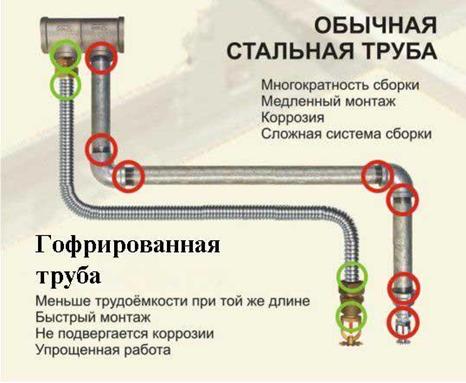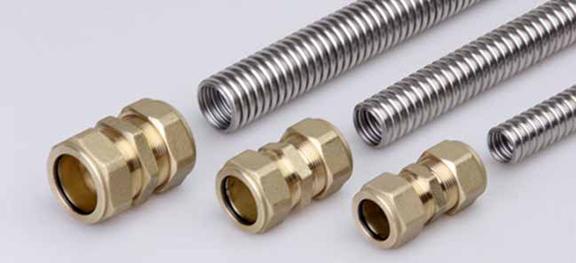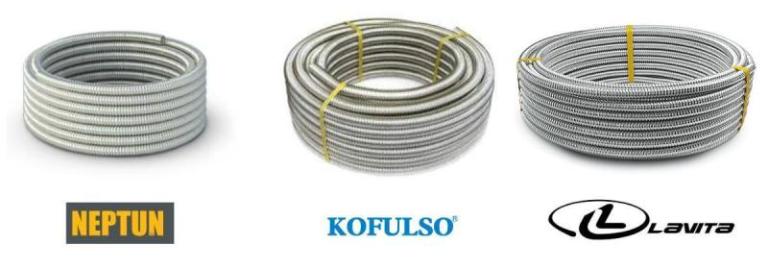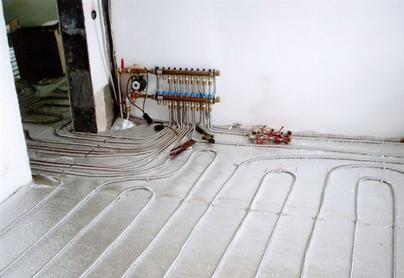Not so long ago, a new element appeared in the assortment of building materials - a corrugated pipe for underfloor heating. The performance characteristics of this material are significantly superior to those of pipes made of polypropylene and copper, and the main advantages of a corrugated pipe are its excellent strength and ease of installation.
Corrugated pipe is easy to install, durable and unpretentious
Important characteristics of pipes for underfloor heating
Laying a water-heated floor is carried out under a concrete screed, and therefore special requirements are imposed on the quality of the pipe, because to repair the damaged area, you will have to disassemble the floor, as well as break the concrete layer. That is why pipes for a water-heated floor must have a certain set of characteristics.
What should be the pipes for a water heated floor

Quality, long service life, ease of installation and unpretentiousness are obvious requirements that apply not only to the pipes themselves, but also to most other building materials and products. In addition to them, water pipes for underfloor heating must meet a number of other requirements:
- Reliability. It is believed that the life of the pipes should be comparable to the life of the building, and therefore be at least 50 years.
- Plastic. Water circuits are on average 60-120 meters long, and when laid they form many bends. That is why the pipes must be plastic, not damaged and not lose their qualities in the places of bending. In other words: the easier the pipe bends, the easier it will be to install.
- Impervious to oxygen. The ingress of oxygen into pipes is the main reason for the formation of corrosion and destruction of the walls.
- Price. A sufficiently large number of pipes are usually laid in the warm floor, so their price should be affordable.
- Mechanical strength. Since the pipes are used on the floor, they must be able to withstand high mechanical loads. In cases where their mechanical strength is low, experts recommend laying an additional layer of reinforcing mesh on top of them to protect them from destruction.
Not all pipes for underfloor heating on the construction market meet all of the above requirements. Products made of cross-linked polyethylene, copper, metal-polymer pipes, as well as corrugated stainless pipe for underfloor heating enjoy a well-deserved trust. However, the latter has such advantages that make it the most desirable material for installing underfloor heating systems.
Advantages of corrugated water pipes

As mentioned above, the main advantages of corrugated water pipes are their strength and ease of installation. In addition, the metal corrugated pipe for underfloor heating has the following advantages:
- Undemanding. Unlike pipes made of copper and plastic, the corrugation does not need preventive cleaning and periodic replacement, so it can be safely poured with a thick layer of concrete or sewn up with panels.
- Security. The corrugated pipe is resistant to ultrahigh temperatures and does not deform even from boiling water (which cannot be said about polymeric materials).
- Ease of installation. To install the pipe, no special equipment is required (for example, in the form of welding equipment and a soldering iron for connecting polypropylene pipes).
- Flexibility. The corrugated pipe for a warm water floor is easily bent at the desired angle, taking the required position and direction. Thanks to this, it is possible to assemble the most complex underfloor heating scheme without much effort and with a minimum amount of connecting fasteners.
- operational endurance. The corrugated pipe is resistant to corrosion, mold and the development of harmful microorganisms. She is also not afraid of rodent attacks, so she can be used in basements and warehouses.
- Wear resistance. The corrugated pipe is able to withstand massive hydraulic shocks with pressures up to 65 bar.
- Versatility. Corrugated pipe for underfloor heating can act as heating radiators, as it has a very high thermal conductivity and heat transfer.
The choice of corrugated pipes for installation of the underfloor heating system
When buying a pipe for organizing a warm floor system in a house, you should pay attention not only to how it meets the requirements listed above; Equally important are also such characteristics as:

- Pipe length (bay footage). The pipe must be long enough to lay one circuit without additional connections. This will prevent potential water leaks at the fasteners, helping to create a more reliable and predictable system.
It is important to remember that the maximum length of a pipe on a circuit is limited by its diameter. So, the length of a circuit built with a pipe 16 mm in diameter should not exceed 70 meters; 20 mm in diameter - 90 meters; 25 mm in diameter - 120 meters.
- Pipe diameter. Pipes with a section of 16, 20, 25 mm are most in demand. When choosing between a thick and thin pipe, it should be remembered that a thick pipe has a greater heat transfer, however, pouring such a pipe requires a much larger volume of cement mixture, which, in turn, leads to an increase in the level of the floor and an increase in the load on the flooring and ceilings.
- Manufacturer. The cost of the pipe, as well as its quality, differ depending on who made it. Russian manufacturers (Ruvinil, Neptun, Kofulso), South Korea (Lavita, Hydrosta), Germany (Meibes) are currently producing corrugated pipes.

- Mechanical strength. This is one of the most important requirements. Metal walls withstand not only the pressure from the concrete screed, but also the internal pressure of the water in the circuit. At the time of emergency water hammer, the pipe must be able to withstand a pressure of 10 bar.
Installation of corrugated water pipes
Laying the contours of the underfloor heating system is not the easiest job, however, if you have experience working with ordinary metal or plastic pipes, even a beginner will be able to do it.

The sequence of actions for the installation of corrugated water pipes is as follows:
- First of all, it is necessary to waterproof the floor with a waterproofing membrane, rubber paint or a ready-made composition based on plasticizers.
- After waterproofing, the floor surface is covered with expanded clay concrete or mortar screed.
- A reflector is laid out on top of the screed (for example, based on foil), and a metal mesh is placed on it.
- At a distance of 15 cm from the wall, a corrugated pipe is laid out (loop pitch - 20 cm) in accordance with the selected laying scheme.
When determining the loop pitch, you should know that the corrugated pipe warms up the floor surface at a distance of 10 cm, so a 20 cm loop completely covers a 40 cm wide zone. To ensure a zone with a comfortable temperature, the loop can be up to 30 cm wide.
- A corrugated pipe (stainless steel) for underfloor heating is attached to a metal mesh using a plastic tie, from which “tails” are cut off after installation.
- Before pouring, the system is pressure tested for 3 hours with a pressure of about 7 atm.
- Then beacons are placed on the floor surface.
- A screed solution is being prepared according to the selected recipe.
- The solution is poured to a height of 5 cm for every 20 cm of area.
- The screed dries for about 1 month (3 weeks in summer, a little over 4 weeks in the rest of the year).
- The first start of the system is carried out in two stages: for the first time, water is started at a temperature of no more than 25 degrees for 24 hours; at the second stage, the water temperature rises to 40 degrees, the screed is dried for several days, after which the warm floor is turned off.
- Tiling is being done.
You can get acquainted with the process of installing corrugated water pipes by watching this video.


















